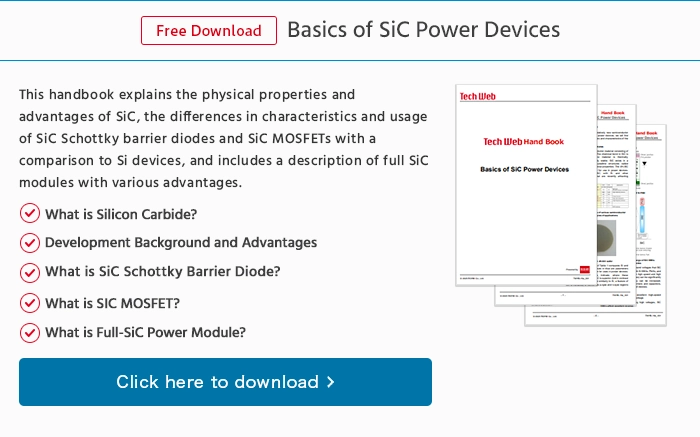SiC<What are SiC Semiconductors?>
Physical Properties and Characteristics of SiC Material
SiC (silicon carbide) is a compound semiconductor composed of silicon and carbide. SiC provides a number of advantages over silicon, including 10x the breakdown electric field strength, 3x the band gap, and enabling a wider range of p- and n-type control required for device construction. Chemical vapor deposition (CVD) is a crucial method for growing SiC layers and producing high-quality single crystals, which are significant for electronic devices and other technological applications.
The result is breakthrough performance, not possible with silicon, making it the most viable successor for next-generation power devices. A variety of polytypes (polymorphs) of SiC exists, each with different physical properties. Of these polytypes, 4H-SiC is the most ideal for power devices due to its high thermal conductivity, which is essential for high-power applications.
| Properties | Si | 4H-SiC | GaAs | GaN |
|---|---|---|---|---|
| Crystal Structure | Diamond | Hexagonal | Zincblende | Hexagonal |
| Energy Gap: EG(eV) | 1.12 | 3.26 | 1.43 | 3.5 |
| Electron Mobility: µn(cm2/VS) | 1400 | 900 | 8500 | 1250 |
| Hole Mobility: µp(cm2/VS) | 500 | 100 | 400 | 200 |
| Breakdown Field: EB(V/cm)X106 | 0.3 | 3 | 0.4 | 3 |
| Thermal Conductivity(W/cm?) | 1.5 | 4.9 | 0.5 | 1.3 |
| Saturation Drift Velocity: vs(cm/s)X107 | 1 | 2.7 | 2 | 2.7 |
| Relative Dielectric Constant: eS | 11.8 | 9.7 | 12.8 | 9.5 |
| p. n Control | ? | ? | ? | ? |
| Thermal Oxide | ? | ? | × | × |
SiC Power Device Characteristics
SiC features 10x the breakdown electric field strength of silicon, making it possible to configure higher voltage (600V to thousands of V) power devices through a thinner drift layer and higher impurity concentration. Compared to conventional silicon devices, SiC power devices offer superior voltage and frequency capabilities, enhancing system efficiency and reducing losses. Since most of the resistance component of high-voltage devices is located in the drift layer resistance, SiC makes it possible to achieve greater withstand voltages with extremely low ON-resistance per unit area. Theoretically, the drift layer resistance per area can be reduced by 300x compared with silicon at the same withstand voltage.
SiC technology also benefits electric vehicles by improving energy conservation and enabling faster charging processes, contributing to the growing demand for EVs.
In order to minimize the increase in ON resistance at higher withstand voltages using silicon, minority carrier devices (bipolar) such as IGBTs (Insulate Gate Bipolar Transistors) are typically used. However, this increases switching loss, which can lead to greater heat generation and limit high frequency operation. SiC devices play a crucial role in critical power systems like traction inverters and on-board chargers in electric vehicles.
In contrast, SiC makes it possible to achieve high withstand voltage using majority carrier devices (Schottky barrier diode, MOSFET) through high-speed device construction, enabling simultaneous high withstand voltage, low ON resistance, and high-speed operation. A 3x wider bandgap allows for a power device to operate at much higher temperatures, considerably expanding applicability. SiC's superior mechanical, chemical, and thermal stability makes it highly advantageous for high voltage power devices.
The evolution and advancements of SiC technology in power electronics continue to drive innovation and performance improvements in the industry.






